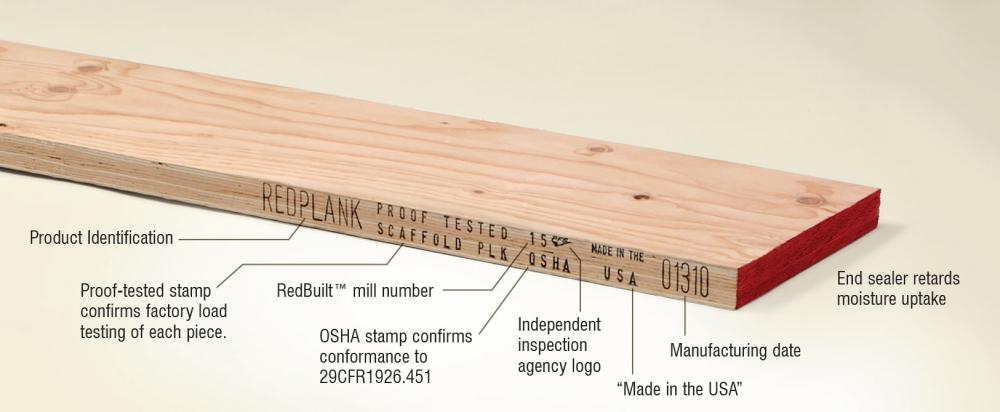
Scaffold planks and platforms are frequently used in harsh environments and are responsible for supporting workers and materials at elevated heights. Every plank must sup- port the loads applied to it, and because failure to do so is potentially life-threatening, the quality of materials and manufacturing of every scaffold plank is vastly important. The challenge for wood-based scaffold planks is that it can be difficult to distinguish a suitable product from a lower grade product not intended for scaffold use.
The issues related to scaffold plank traceability are understandable; however, the ramifications of inadequate traceability tend to be ignored. This can be costly to all involved, especially when there is a problem with performance or application.
Adequate traceability can be simplified as follows:
The Why
There are many products that without proper traceability have no great impact on our lives—items generally low in cost, non-life threatening, and easy to operate (no need for information from the manufacturer).
But take a car, for example. A car needs proper traceability, or you probably wouldn’t make the purchase. It is a significant investment, and any defects in functionality could create life-threatening safety hazards. Therefore, a detailed owner’s manual is always provided by the manufacturer, often along with a network of authorized dealers to assist with service and maintenance. Would you purchase a car off a lot at a deal if it didn’t have a make, model, manufacturer name or emblem, or a VIN number? Is the risk of not knowing if you’re in a safe vehicle worth the reward of a deal way below sticker?
The same concept applies to scaffold planks. They are a significant investment for distributors, owners, and users. The performance and quality of each plank is critical to the safety of their users. Additionally, while scaffold planks aren’t exactly complicated to operate, there is significant value in having technical and field support provided by the manufacturer, and the ability to easily identify who that manufacturer is and how they can be contacted.
The What
So what defines adequate traceability? Simply answered, traceability concerning scaffold plank should at a minimum give clear information as to who manufactured the plank, when, and where it was produced. This information should be permanently embossed on both sides of the plank.
One piece of essential information is a marking that indicates the product is specifically “SCAFFOLD PLANK” or “SCAF PLK”. This is particularly important for wood-based scaffold planks that bear similar resemblance to lower-grade products not intended for scaffold use. Additionally, many manufacturers of scaffold plank in North America will include an OSHA or CSA S259.2 marking to indicate conformance with the applicable scaffold regulations in the U.S. and Canada, respectively.
The Who
While it is not a requirement that the plank manufacturer’s name be fully spelled out, it is important that either the product name or logo, or the manufacturer’s name or logo can be easily determined. For wood-based plank products, the grade agency or third-party inspection agency used by the manufacturer must be included. This is critical information to have in case the quality or safety of a product from a production lot is called into question.
The Where
The markings on a plank should include the manufacturer’s mill number assigned by the respective agency. This provides critical information as to where the plank was manufactured. Some manufacturers will further identify their product with the country of origin with a claim like “Made in USA” or similar.
The When
The date or production period when scaffold plank was produced is also of critical importance. The product should include a date stamp of a month and year, a specific date, or a time the product was produced. Again, knowing when the plank was produced is essential information to have should the product’s quality or safety from a given production lot be called into question. These markings tie back to important information from the manufacturer including: raw mate- rial sources, production data, process control, and quality assurance data from the time period in question. While manufacturers may have varying degrees of internal traceability, it can generally be stated that the tighter the time-frame on a production period listed on the product the better. For example, traceability to an hour of production would be better than to a day or shift of production; and traceability to a day or shift of production would be better than to a month of production.
The How
It is largely up to the product manufacturer to determine how to imprint this information on their product. There are several different ways to provide traceability and technology continues to produce more innovative ways to do so. Because of jobsite conditions and the environmental elements scaffold planks are exposed to, markings for traceability should be able to withstand the elements and still be readable well into the product’s service life. For this reason permanent emboss is highly recommended over ink stamps on wood-based plank products.
It is possible to get a good deal in the scaffold plank industry on products with poor traceability. Typically, inadequate traceability is the direct result of a questionable material source. But questionable traceability puts everyone involved at risk.
Any questions about meanings of markings or concern of adequate traceability are best addressed directly with the plank manufacturer.
Traceability Guidelines
OSHA, the American National Standards Institute, and the SAIA provide regulations, minimum design properties, and recommendations about proper traceability of scaffold plank products. A description of the required information is covered in Purchasing Guidelines developed by SAIA’s Plank & Platform Council for various scaffold plank and platform products.
The guidelines are available at: www.saiaonline.org/ plankandplatform